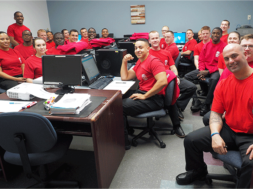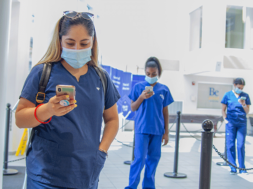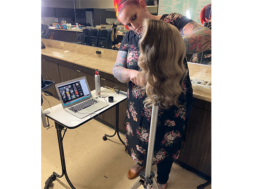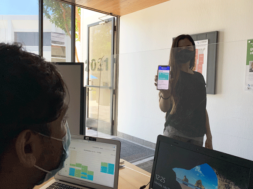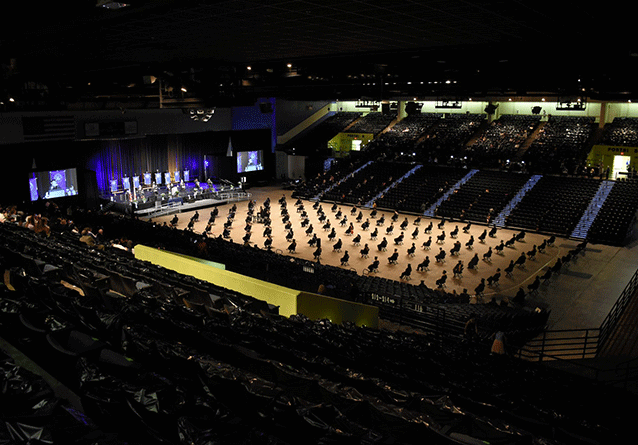
Career Colleges use Lessons From Pandemic as They Move to Reopen Campuses in Fall
Written from interviews with career college and university leaders
In the wake of the COVID-19 pandemic, career colleges and universities across the country carefully reopened their institutions holding virtual or hybrid courses. But school administrators say they learned a lot in the last year, and those lessons should help as they move to fully reopen their schools this fall.
Pima Medical Institute
Jen Spurlin, director of academic affairs for Pima Medical Institute, said state mandates and guidelines changed continuously during the pandemic. But, Pima Medical kept student learning and safety in mind as it transitioned to a hybrid learning model, instituting some of their lab instruction online, while skill competencies were done in person with small groups and staggered times.
“We are maintaining the six-foot distance as long as we can,” Spurlin said. Full PPE is required when students need to be on campus. Plus, Pima Medical is doing symptom checks before students arrive on site.
Spurlin said Pima Medical was using Blackboard before the pandemic, which was already generating a course for all their on-ground classes.
“That helped make it very streamlined when we went to online overnight,” she said, noting that instructors just had to start offering all their lectures online.
Zoom was also a useful tool, she said, because they require a synchronous component to their courses. Their Houston campus also found Go-Pro cameras helpful, as it allowed instructors to easily record and show steps and processes.
Phillip Heine, campus director of Pima Medical in Houston, Texas, said they conduct didactic classes virtually, while students come on campus for the lab portion of their classes.
“We have students come in in groups of nine or less so it is the instructor and nine students,” he said. “We practice social distancing and we are still mandating that everybody in the building wear a mask.” They have also closed certain areas like the student and employee lounges.
For the clinical portion of class, Pima Medical works with the employers – the hospitals, the doctors, the dentists, the veterinarians, etc. – to ensure safety protocols are in place. While most of the employers shut down their operations in March or April 2020 when Texas shut down, Pima Medical students have been able to get their externships and on-the-job training in once they opened, with the exception of nursing aides, who were not allowed to work in long-term care facilities, Heine said.
Spurlin said students’ ability to complete clinicals was difficult during the pandemic.
“Where we really saw the crunch was with our hospital-based programs like radiography and respiratory therapy,” she said. “They were a little slower to start opening those sites back up, but we’re getting there.”
Pima Medical implemented a 13-page Alternative Clinical Education (ACE) plan, which outlines the guidelines established by Pima Medical for using simulated clinical experiences for up to 50% of an externship course hours.
“Our corporate and regulation teams are very cautious,” Spurlin said. “We have about 170 individual programs across our campuses and each one has an ACE plan that is individually approved.”
Spurlin said it’s important to ensure that students are getting hands-on experience, but it’s equally important they’re being connected with future employers, noting that none of their certificate students are on an ACE plan. “We do still have some degree programs that are more hospital-based that are utilizing some of those simulation hours, but we are really … monitoring that and pulling them off those ACE plans as soon as possible.”
But that doesn’t mean that there will ever be a pre-COVID Pima Medical Institute. “Our perspective on this was that it was a terrible thing, but we have to breed innovation out of it,” Spurlin said.
Since all their campuses are on different schedules as far as their sequence and semester starts, Pima Medical decided to bring back programs in-person during August and September.
Pima Medical will also offer hybrid versions of its certificate programs. “So if prospective students come to us and they want that daily check-in and the mornings work for them, they would do the on-ground version of the program,” she said. However, in the afternoons they will offer hybrid versions of instruction, allowing students to be online two or three days a week.
Currently, employees who don’t need to be on campus are working remotely unless it’s by their choice, she said. But by July 6, all staff and faculty will be back in person as they prepare for the returning students.
Spurlin said Pima Medical is “highly encouraging” students and staff to be vaccinated, but they are not mandating it and noting that certain clinical sites do require it. They also have created a system for students and employees to upload their proof of vaccination so they know who would need to quarantine if they are exposed to the virus. They treat the COVID-19 vaccine just as they do any other immunizations, she said.
Spurlin said their biggest challenge during the pandemic was creating systems, policies and processes for the majority.
“There are going to be students who can’t get the vaccine or students who end up not feeling comfortable coming back to school,” she said. “The hardest challenges (were) to make policy decisions … (that) serve the majority.”
Pima Medical’s vaccine policy includes a 38-page mitigation and recovery plan that is updated as conditions change and is shared with all campuses nationwide. However, their Continuity of Education Plan’s success goes to the fact that it was created with input from all their campus directors and top administrators.
“We were at the ABHES conference in Houston when all this started happening last year,” Spurlin recalled. It was the last day of the conference, and they spent it together in a banquet room deciding how they would handle COVID-19 and continue teaching.
The 20-page continuity plan includes expectations and best practices, as well as Blackboard guidelines and instructions.
“We had 600 faculty we had to train overnight … and it really was as seamless as it could be. It definitely took hard work by the instructors,” Spurlin said.
Heine said administrators at Pima Medical’s Houston campus learned students were resilient and adapted quickly to changing conditions during the pandemic. But the school also adapted, for example holding its graduation ceremony at a drive-in theater, Heine said.
“We had all the speeches recorded and had students come in individually and get their gowns and have their pictures taken,” Heine said. “In the beginning, we had their pictures go across the screen, like they’re marching in.”
Each student was also able to make a short comment that they shared on the screen — like who they were or who they wanted to thank. The ceremony also featured sentimental pictures related to COVID-19. Then, when the graduates would drive out at the end, they would be handed their diplomas or degrees.
Their April 30 graduation was held at their usual site, but was divided into three ceremonies to allow for social distancing. They included some recorded video speeches, and left enough time between ceremonies so the facility could be disinfected.
The pandemic made everyone be creative, and Heine said that made things more rewarding because it meant so much to people whose lives had been interrupted.
For instance, they held a socially distanced holiday party. Employees could come in, grab a box lunch and take it to their reserved spot. They brought in a comedian, watched a movie and gave away prizes.
Besides aiding in creativity, Spurlin said the pandemic also increased partnerships, likely due to the fact that healthcare became a major player.
“We have worked in the last year with more employers reaching out, wanting to upskill their employees or looking to fill a workforce gap,” Spurlin said. “Because we’re a healthcare school, it immediately shined a light on the workforce gap and the real need in our community for more healthcare providers.”
The pandemic also shined a light on healthcare professions like respiratory therapy that many people didn’t know about. “We’ve definitely seen an increased awareness in the career field, and we’ve seen that with our census as well,” she said. Student retention has also been high, at 87% retention overall, she said.
The Modern College of Design
Jessica Barry, president of the Modern College of Design in Kettering, Ohio, said after starting the fall semester using a hybrid teaching model, their college went 100% remote in November as COVID-19 transmission increased in their county.
“We decided that the consistency in the delivery model was most important for our students,” Barry said. “And we knew in January that we couldn’t promise that we could be on campus so we decided to go fully remote for our spring term.”
However, their campus is open so students have access to all resources, particularly their photography studio and other equipment. The college focuses on graphic design, web design, illustration, video, animation and other areas of the marketing industry.
As of mid-April, the college required masks and social distancing in classrooms. Barry said it’s meant that they have cut their classroom size in half to about 10 to meet the current mandate.
But MCD plans to be back fully in person for its next term, which starts May 10.
“Our May term is one of the smallest for enrollment because most of their students are out doing internships,” she said. That allows their classes to be smaller.
“Social distancing will still be in place, mask wearing will still be in place. We’re not requiring vaccines, but many of our faculty, staff and students are in the process of getting vaccines,” she said. “We hope that will create an even safer environment than what we previously had.”
Barry said they hope that cases will continue to decline in Montgomery County and that by the end of August they can be fully back in person. But some things will stay the same post-COVID-19. For instance, some faculty and staff may continue to work remotely, the college will continue to offer some online courses, and it will continue to update its technological infrastructure — they have already upgraded their CRM from a FileMaker database to LeadSquared and their LMS from Moodle to Canvas.
Canvas is the tool that most helped to improve their student outcomes, she said, since students have so much more data at their fingertips, including grades, attendance and classroom materials and information. “It’s really been a game changer for both our students and our faculty,” she said.
She said the response from students and faculty to online learning has been positive.
“We are starting to attract different students who really need the flexibility of online programs,” Barry said. “It’s opening us up to students who can’t be on campus because of responsibilities they have in their life.”
That new group of potential students has caused the school to change its marketing strategy.
“Prior to the pandemic, our recruitment strategy was based on a high school recruitment strategy,” Barry said. “When the high schools closed, and we no longer had that avenue, we turned to a digital strategy through Google and Facebook advertising,” she said. “Now as schools are reopening we’re trying to balance those two.”
While enrollment was down a little last year, Barry said most were high school students who decided to take a year off before pursuing their degree.
“Those are the students that we’ve continued to develop a relationship with, and they have attended workshops and gotten to know us better and develop their skills,” she said. “And now they’ll be joining us in either June or August of this year.”
The college offers workshops in design and leadership, and allows students to see the opportunities the industry offers, as well as offer participants a $100 scholarship per workshop, up to $400.
The Modern College of Design was one of the few that was able to hold an in-person graduation last year.
“We had eight different ceremonies, all in one day with somewhere between 10 to 15 graduates in each ceremony,” Barry said. “Each student was able to invite up to six guests. The theater that we have our graduation holds up to 1,000 so there was plenty of room to socially distance.”
They are currently planning for their June 6 graduation ceremony, but holding off on announcing plans in case guidance changes, she said.
“This is the first year that we have a graduating class where we are awarding bachelor’s degrees, so it is a really big year for the students, but also for the faculty and staff who have worked on that program and nurtured those students for four years,” Barry said. They expect to have about 70 graduates for the class.
Barry said the most challenging thing to deal with in the last year has been the faster pace needed to make strategic decisions.
“We were used to being very methodical about research and development of any new programs or any new technologies that were used within the college, and COVID did not allow us that kind of time,” she said. “We had to work much faster, and be in an environment where we were having to troubleshoot things on the fly. But we’re quickly adapting and seeing the benefits of moving at a faster pace.”
Barry said she’s been impressed by how resilient their students, faculty and staff have been throughout the year. One academic team competed virtually in a national competition and placed 11th in the country. “They were actually our most successful team to date,” she said.
In addition, she said their students who are graduating now are more prepared for the industry than past graduates. “They have this brand-new mindset … that students didn’t have in the past,” she said. “They’re completely comfortable with working remotely and staying engaged and motivated.”
Keiser University
Like many other colleges and universities, Keiser University closed in March 2020 when Florida shut down all schools. But prior to the pandemic, Keiser had put all of its classes online and started using the Blackboard learning management platform, knowing they were in a hurricane zone, said Dr. Art Keiser, chancellor and CEO of Keiser University. So Keiser was ready for the challenges of virtual instruction.
“If you were a faculty member or student in a classroom on campus, you had at your disposal Blackboard, a login, and you’d be able to communicate with your instructor, pull down library resources, take tests and turn in papers,” Keiser said. The university also had an internet-based telephone system that allowed financial aid, admissions and other departments to communicate directly to everyone’s computers and telephones, even if they were working from home.
“I’m pleased and proud to say my staff really had us prepared,” Keiser said. “We have 19 campuses in Florida and overseas, and over 20,000 students and 4,000 employees, and we were not missing a beat.”
Keiser said their retention for the first six months of the coronavirus was better than the same period year over year, and their student satisfaction was up 1 percentage point to 95% in August 2020.
By May, while students continued to learn at home, Keiser began bringing staff and faculty back on a 50/50 ratio so there would not be any social distancing issues. They purchased electronic temperature measurement devices, personal protection equipment and plastic shields. Everyone had to wear a wristband to confirm they had been checked for symptoms before being allowed on campus.
That attention to detail paid off. “We’ve been very limited in the number of cases, and none have been clusters on campus,” he said.
In September 2020, Keiser University reopened its schools for students and taught in a hybrid manner. Students had one-third of their classes on campus and two-thirds online, although staff continues to be on campus on a 50/50 ratio.
Keiser said their goal is to be fully open on campus in September 2021, and have staff, faculty and students back.
Like Pima, they are not requiring staff to get vaccinated. “But we’re giving people time off to go get the vaccines … and working with the Department of Health to get faculty and students vaccinated,” he said.
The main thing Keiser said he learned in the last year is that their university was much better prepared than most institutions.
“Most of the students adapted extraordinarily well to the online environment,” he said. “Our faculty members really did a good job. We required all of the deans to go to every classroom at least once a week to make sure that everybody was working. I’m pleased that our students have continued to learn…”
Enrollment also continues to climb. “I’m not sure it’s because of COVID-19; I think it’s because of unemployment. Most of the schools in our sector that are career oriented have done well.”
However, those universities with residential halls saw decreases, he said, as parents were afraid to send their children to live in dorms.
At this point, Keiser isn’t sure how many hybrid courses they will offer once the pandemic ends.
“I’ve done a lot of interviewing with students … and they were very happy to be back on campus. I think we’ll see some students who want to go to a hybrid online environment. But most of the kids coming back full time would rather be in class.”
However, technological tools did help make the last year go smoother, and they’ll be looking for more educational technological advances in the future, he said, as well as virtual reality tools and electronic simulators.
For instance, an ultrasound student was able to use a software program that allowed her to use a mouse to simulate the use of an ultrasound machine. “She said that was really wonderful for her to practice and be prepared (before) going back to the actual ultrasound equipment,” Keiser said.
University of Advancing Technology
Despite the pandemic, the University of Advancing Technology in Tempe, Arizona, held in-person classes the entire year for those students living in dorms, said Valerie Cimarossa, vice president of marketing and technology.
To stay open, they followed guidance from the local health authority, as well as from the Centers for Disease Control and Prevention. And if the organizations had varying advice, they followed the one that was most restrictive, she said.
“We kept a pretty secure bubble,” Cimarossa said. “We only had one case on campus, and it wasn’t transmitted to anybody else …”
She said they basically restricted all public access, allowing only students who needed campus resources to continue their classes in person. In addition, only vendors required to maintain the campus environment were allowed on campus, and nobody except those living in the dorms were allowed inside the residence halls.
Cimarossa said they set up temperature check stations at each of their entrances, and closed other entrances and exits to create a safer traffic flow. They also added signage about safety protocols and offered on-site COVID-19 testing.
In addition, their janitorial crew updated its cleaning protocols, and their HVAC company installed and upgraded air filters, even installing permanent air scrubber fixtures on some units, she said.
UAT’s delivery modality was flexible and virtual, making the transition easier, she said. They offered live classes that students could attend virtually through Microsoft Teams. While most of the faculty had taught a class in that format before, those who hadn’t were quickly trained, she said.
“We were still running living courses … it was just virtual at home. The students who were on campus could also attend virtually from their rooms or from a computer somewhere in the commons,” she said.
However, many students who had gone home for spring break did not return to campus. When they started to bring back some of the classes in person, whoever was comfortable attending in person could go, although they restricted the number of students to ensure social distancing.
Cimarossa said UAT plans to be back to normal by Fall 2021, including having the bulk of their classes available in person.
While the year was certainly challenging for all schools, she said they learned a lot, too, from the process.
“We learned we … have the bandwidth to run all our classes in a multi-delivery, virtual live asynchronous method if we need to,” she said. “And we have some new data points that we … can look to for insight on student engagement, which will serve our retention efforts and future opportunities for improvement.”
Student retention was high throughout the pandemic, and Cimarossa said they learned what type of events students want. They also learned a lot about trends and behaviors when it comes to what students and parents are looking for as they make a decision about where to attend college.
Lastly, they learned what virtual classrooms could look like, and how to effectively expand their reach beyond the building. “We learned a lot about how to include our online population in our student events, which is great because having access to the community is so important,” Cimarossa said.
The UAT offers more than 20 STEM majors at the associate, bachelor’s and master’s levels. Their largest group of students is those between 18 and 24 years old, and during regular times, there tends to be a 60/40 or 70/30 split of students being on campus vs. virtual. However, during the pandemic, about 50% of their students attended online, she said.
Cimarossa said the most helpful new tool they used during the pandemic was a student counseling and training service. It was fully remote and students could reach out for support. Much of the support has been regarding mental health, but UAT also helps students find babysitters, connect with legal help, or create a better work-life balance.
“It’s a pretty cool service in the way that they’re licensed,” she said. “We can now also offer it to our online students, whereas before traditional counselors … (were) only licensed to counsel in the state.”
While UAT didn’t offer any new programs during COVID-19, they did add mid-semester start dates for undergraduates. “Now if a student graduates in May or June, they have an opportunity to start in July and get a jump on the fall,” she said.
Looking back at last year, their biggest challenge was keeping track of the health guidelines and recommendations, and making sure UAT was staying up to date with those, Cimarossa said. “There was that time during the late summer where they were literally changing every week.”




